Connect With Us
Blog
Items filtered by date: November 2023
Treating Diabetic Foot and Ankle Trauma

Managing foot and ankle injuries in diabetic patients is complex. There is no one-size-fits-all approach for surgeries in these cases. Diabetic injuries can involve different types of bone breaks and dislocations, making treatment difficult. A major challenge is dealing with the limited soft tissue in the foot and ankle, which can easily become damaged. This is especially difficult in diabetic patients who might have other health issues like poor blood circulation or weak immune systems. Podiatrists treat surgeries in diabetic patients carefully to avoid harming the soft tissue and ensure proper healing. They often use special techniques, like minimal cuts or external supports, to repair the bones while protecting the skin and muscles. In severe cases, they may perform the surgery in stages. For diabetic patients, keeping bones stable and avoiding further injury is crucial, which sometimes involves additional support for nearby joints. If you are a diabetic patient and have sustained a foot or ankle injury, it is suggested that you make an appointment with a podiatrist immediately. This medical professional can make a proper diagnosis and evaluation, with a determination of whether surgery is right for you.
Foot and ankle trauma is common among athletes and the elderly. If you have concerns that you may have experienced trauma to the foot and ankle, consult with Dr. Eddy Caldwell from Foot Care of Northeast Arkansas, P.A.. Our doctor will assess your condition and provide you with quality foot and ankle treatment.
Foot and ankle trauma cover a range of injuries all over the foot; common injuries include:
- Broken bones
- Muscle strains
- Injuries to the tendons and ligaments
- Stress fractures
Symptoms
Symptoms of foot and ankle injuries vary depending on the injury, but more common ones include:
- Bruising
- Inflammation/ Swelling
- Pain
Diagnosis
To properly diagnose the exact type of injury, podiatrists will conduct a number of different tests. Some of these include sensation and visual tests, X-rays, and MRIs. Medical and family histories will also be taken into account.
Treatment
Once the injury has been diagnosed, the podiatrist can than offer the best treatment options for you. In less severe cases, rest and keeping pressure off the foot may be all that’s necessary. Orthotics, such as a specially made shoes, or immobilization devices, like splints or casts, may be deemed necessary. Finally, if the injury is severe enough, surgery may be necessary.
If you have any questions, please feel free to contact our office located in Jonesboro, AR . We offer the newest diagnostic and treatment technologies for all your foot care needs.
Definition and Root Causes of Plantar Fasciitis

Plantar fasciitis, a common ailment that affects the feet, reveals itself as an inflammation of the plantar fascia, which is the band of tissue connecting the heel bone to the toes. This vital ligament plays a pivotal role in supporting the arch of the foot and absorbing shock during movement. The onset of plantar fasciitis often stems from repetitive stress or overuse, manifesting in micro-tears that lead to inflammation and pain. Contributing factors can include excessive standing, walking, or running, especially on hard surfaces, as well as wearing ill-fitting footwear that fails to provide adequate support. Tight calf muscles and abnormal foot mechanics can also contribute to the strain on the plantar fascia. Understanding the definition and causes of plantar fasciitis enables individuals to adopt preventive measures. If you have developed plantar fasciitis, it is suggested that you speak to a podiatrist who can help you with effective treatment methods, in addition to providing you with relief techniques for this painful condition.
Plantar fasciitis can be very painful and inconvenient. If you are experiencing heel pain or symptoms of plantar fasciitis, contact Dr. Eddy Caldwell from Foot Care of Northeast Arkansas, P.A.. Our doctor can provide the care you need to keep you pain-free and on your feet.
What Is Plantar Fasciitis?
Plantar fasciitis is the inflammation of the thick band of tissue that runs along the bottom of your foot, known as the plantar fascia, and causes mild to severe heel pain.
What Causes Plantar Fasciitis?
- Excessive running
- Non-supportive shoes
- Overpronation
- Repeated stretching and tearing of the plantar fascia
How Can It Be Treated?
- Conservative measures – anti-inflammatories, ice packs, stretching exercises, physical therapy, orthotic devices
- Shockwave therapy – sound waves are sent to the affected area to facilitate healing and are usually used for chronic cases of plantar fasciitis
- Surgery – usually only used as a last resort when all else fails. The plantar fascia can be surgically detached from the heel
While very treatable, plantar fasciitis is definitely not something that should be ignored. Especially in severe cases, speaking to your doctor right away is highly recommended to avoid complications and severe heel pain. Your podiatrist can work with you to provide the appropriate treatment options tailored to your condition.
If you have any questions please feel free to contact our office located in Jonesboro, AR . We offer the newest diagnostic and treatment technologies for all your foot and ankle needs.
Who Benefits From Laser Treatment for Fungal Toenails?

Laser therapy uses focused light to destroy toenail fungus, preventing it from spreading or getting worse. This type of treatment has evolved since the 1980s with various lasers now in use, affecting the success rate for different individuals. Laser treatment can be particularly useful for individuals who cannot take certain medications due to liver or kidney problems, in addition to people with diabetes, and older adults who might not tolerate drugs well. Early treatment of toenail fungus is advised by the CDC to stop the spread of the infection and ensure better results. If not treated, the fungus may spread beyond the toenails. If you have toenail fungus, particularly if it does not resolve with more conservative treatment, it is suggested that you make an appointment with a podiatrist to discuss whether laser treatment may be an option worth considering.
Laser treatment can be an effective way to get rid of toenail fungus. If you have any questions about laser treatment, consult with Dr. Eddy Caldwell from Foot Care of Northeast Arkansas, P.A.. Our doctor will assess your condition and provide you with quality treatment for fungal nails.
What Are Toenail Fungal Infections?
Onychomycosis, or fungal infection of the nail, is a relatively common and non-serious condition. Around 10 percent of U.S. citizens are afflicted with fungal nails. Common forms of fungus that infect the nail include dermatophytes, yeasts, and molds.
Symptoms of Toenail Fungal Infections Include:
- Nail thickening
- Brittleness of the nail
- Discoloration of the nail
Diagnosis for Fungal Nails
Fungal infections are diagnosed by fungal culture and microscopy. This will rule out any other conditions such as nail trauma, psoriasis, lichen planus, and onychogryphosis.
What Is Laser Treatment?
Laser treatment is a non-invasive, safe, quick, and painless procedure that uses the heat from a laser to kill fungus in the nail. Each infected nail is targeted with a laser for several minutes. The treatment is usually utilized several different times over a select period. During this time, a podiatrist will keep an eye on the infection.
If you have any questions, please feel free to contact our office located in Jonesboro, AR . We offer the newest diagnostic and treatment technologies for all your foot care needs.
Get Professional Care for a Broken Foot or Ankle
Surgery May Relieve Painful Corns

Corns on the feet are most commonly caused by excessive pressure on the toe or bottom of the foot from wearing tight or ill-fitting shoes. When painful corns on your feet become unbearable and conservative treatments no longer work, surgery is a viable option. Corns, known medically as heloma, can become excruciating, making even the simplest daily activities a painful ordeal. The surgical procedure involves making a small incision over the affected toe to access the corn. The foot doctor removes the corn, repairs any tendon that may be involved, and closes the incision. Various numbing options, including general anesthesia, a spinal block, or local anesthesia with sedation, are offered based on the severity of the procedure. Surgery for painful corns addresses the root causes of discomfort and can provide a permanent solution. If persistent corn-related pain affects your life, it is suggested that you make an appointment with a podiatrist. This foot doctor can assess the need for surgery or offer other treatment options as needed.
If you have any concerns regarding your feet and ankles, contact Dr. Eddy Caldwell of Foot Care of Northeast Arkansas, P.A.. Our doctor will treat your foot and ankle needs.
Corns: What Are They? and How Do You Get Rid of Them?
Corns can be described as areas of the skin that have thickened to the point of becoming painful or irritating. They are often layers and layers of the skin that have become dry and rough, and are normally smaller than calluses.
Ways to Prevent Corns
There are many ways to get rid of painful corns such as wearing:
- Well-fitting socks
- Comfortable shoes that are not tight around your foot
- Shoes that offer support
Treating Corns
Treatment of corns involves removing the dead skin that has built up in the specific area of the foot. Consult with Our doctor to determine the best treatment option for your case of corns.
If you have any questions please feel free to contact our office located in Jonesboro, AR . We offer the newest diagnostic and treatment technologies for all your foot and ankle needs.






